Global Private Equity Report
 }
}
At a Glance
- Software investors continue to ride the extraordinary wave of technological transformation that is sweeping the global economy.
- They are also paying extraordinary asset prices that reflect the widespread belief that growth is still in its early stages.
- That’s a risk, but top-tier software specialists manage it with hyperfocus, flexible mandates, and the ability to create value through active ownership.
This article is part of Bain’s 2022 Global Private Equity Report
When venture capitalist Marc Andreessen famously wrote in 2011 that “software is eating the world,” private equity investors were clearly paying attention. Since then, private investments in software and technology have exploded to become the industry’s dominant area of focus, and investors continue to flood the zone with new capital.
The $284 billion in tech deals private equity investors closed in 2021 accounted for 25% of total buyout value and 31% of deal count during the year, comprising by far the largest share for any single sector (see Figure 1). Software deals made up $256 billion, or 90% of the total tech value, with much of that activity involving public-to-private (P2P) transactions. Indeed, $105 billion, or 41% of the software total, involved buyouts of large, maturing public companies like Proofpoint and Cloudera that had lost some of their luster with retail investors despite continued growth prospects.
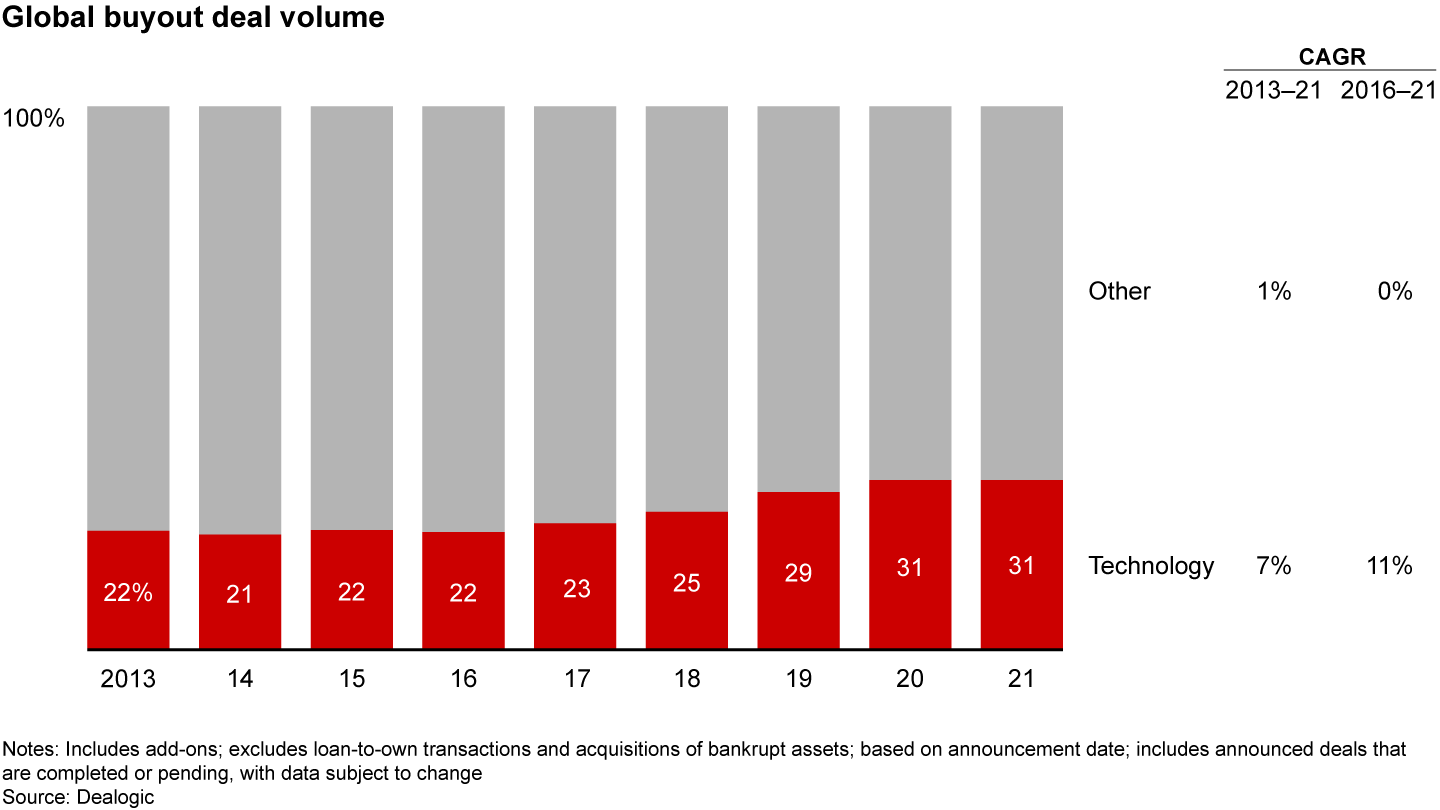
What’s clear is that investor appetite for B2B software and technology is only increasing. Since 2016, tech funds have raised more than $270 billion, or 13% of the total capital raised globally during that period (see Figure 2). Massive $5 billion–plus specialist funds like those sponsored by Thoma Bravo, Vista Equity, and Silver Lake have accounted for 62% of technology fund-raising since 2016 (see Figure 3). But multisector players like Blackstone, Bain Capital, KKR, and TPG have also made their presence felt. In addition to investing out of their general funds, each has raised a $1 billion–plus fund aimed at technology, and they are increasingly looking to expand into earlier-stage growth equity investments.
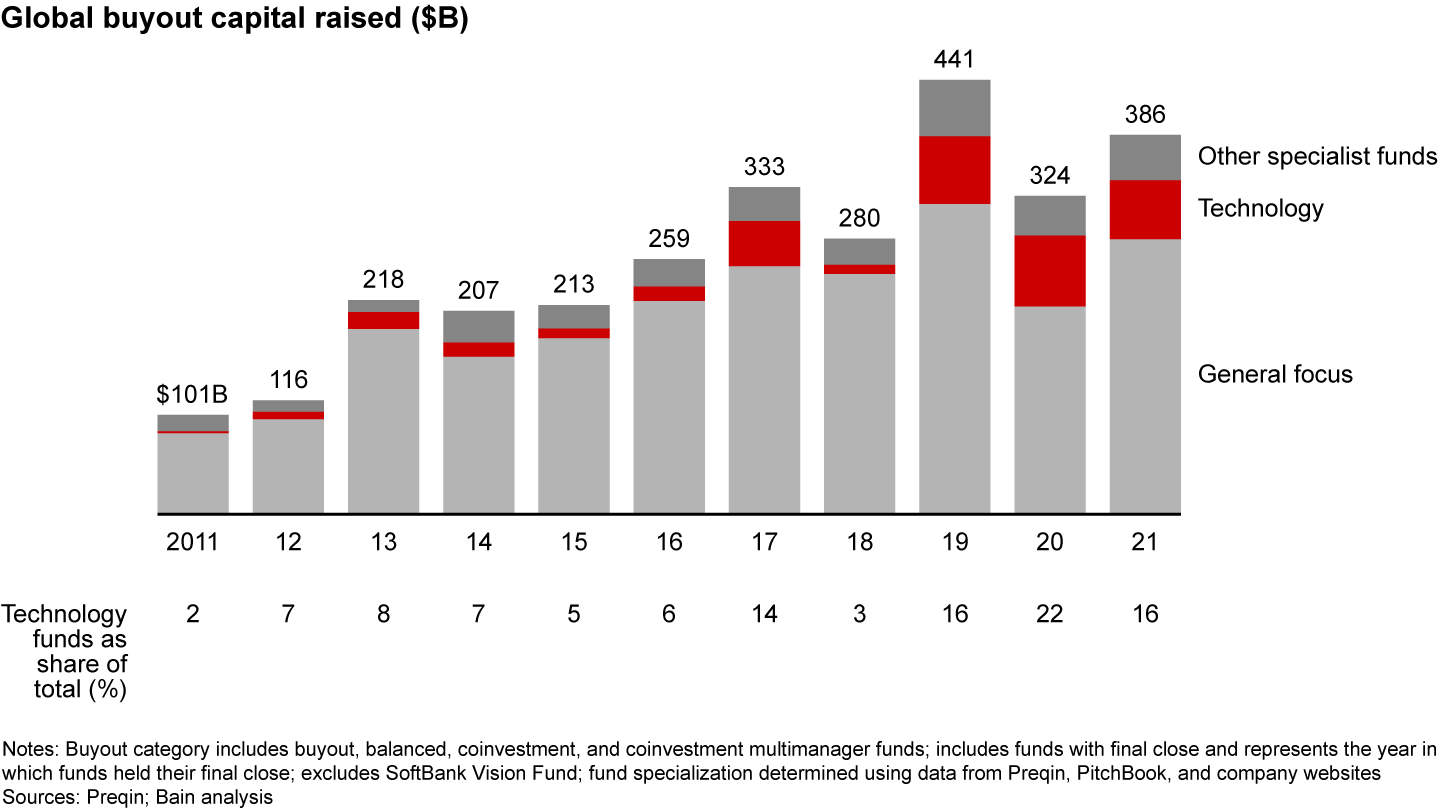
The basic rationale behind this decade-long burst of activity is the same one Andreessen spelled out in 2011. He argued in the Wall Street Journal that technology and networking had matured to a tipping point that was ushering in a structural shift in the global economy. Disruptors were increasingly “invading and overturning established industry structures,” and software was altering how a growing number of major businesses and industries operated. Many of the companies that emerged to take advantage of this paradigm shift have since matured into prime buyout candidates. And a growing number of investors are convinced the shift is still in its early stages.
The valuation question
Unsurprisingly, the resulting competition for deals in the software sector has led to ever-higher multiples and regular speculation that valuations may be getting ahead of themselves (see Figure 4). Yet the performance of these investments has so far provided a firm rebuttal to the skeptics. While fast-growing technology companies are typically associated with higher risk, the mature or maturing enterprise software companies private equity has gravitated toward have actually turned out to be less risky and volatile than other investments.
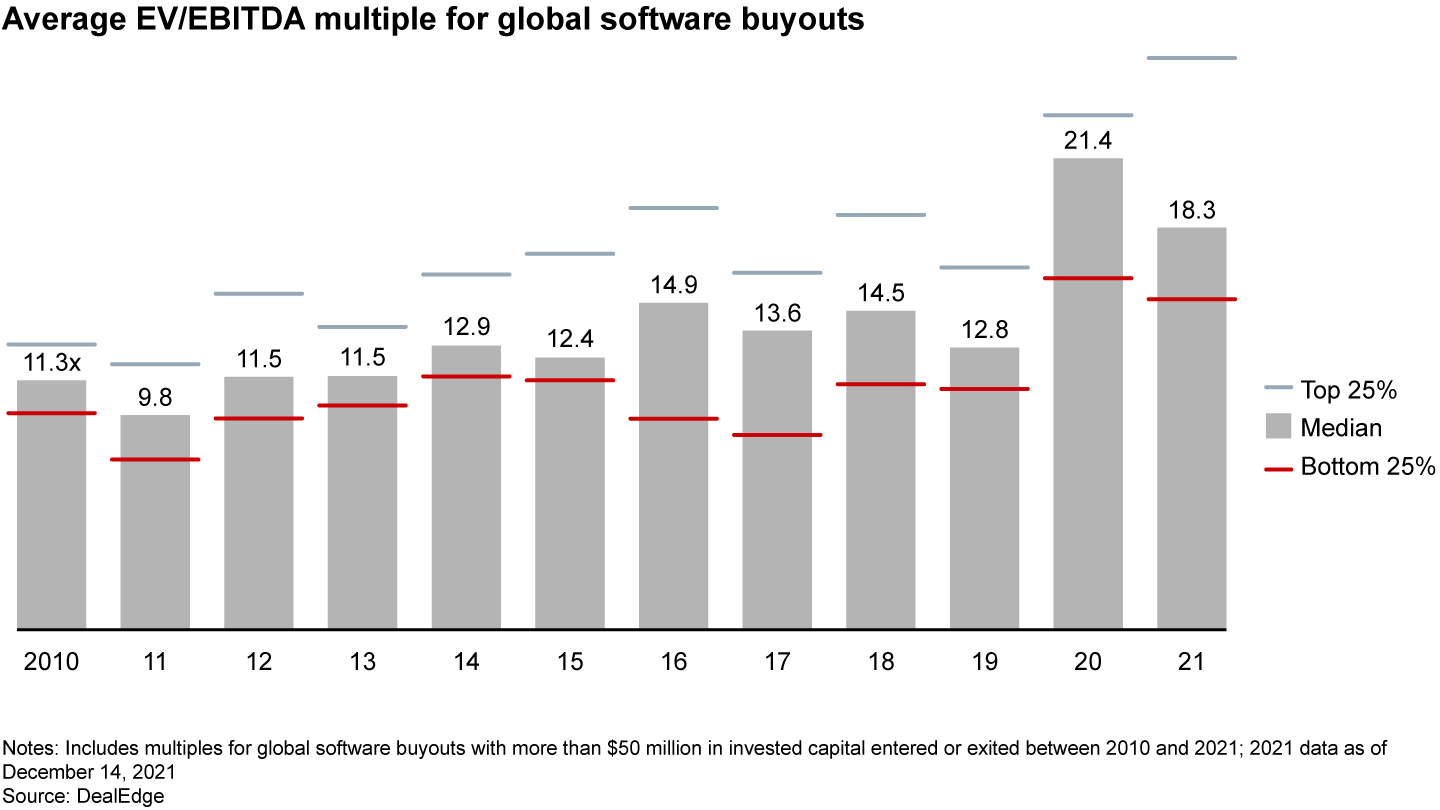
A Bain & Company analysis of technology deals over the past decade shows that, while hurdle rates for software investments have been about the same as for other industries (a target internal rate of return of around 22% on average), software investments were more likely to outperform and by a wider margin. They were also less likely than buyouts in other sectors to lose money (see Figure 5).
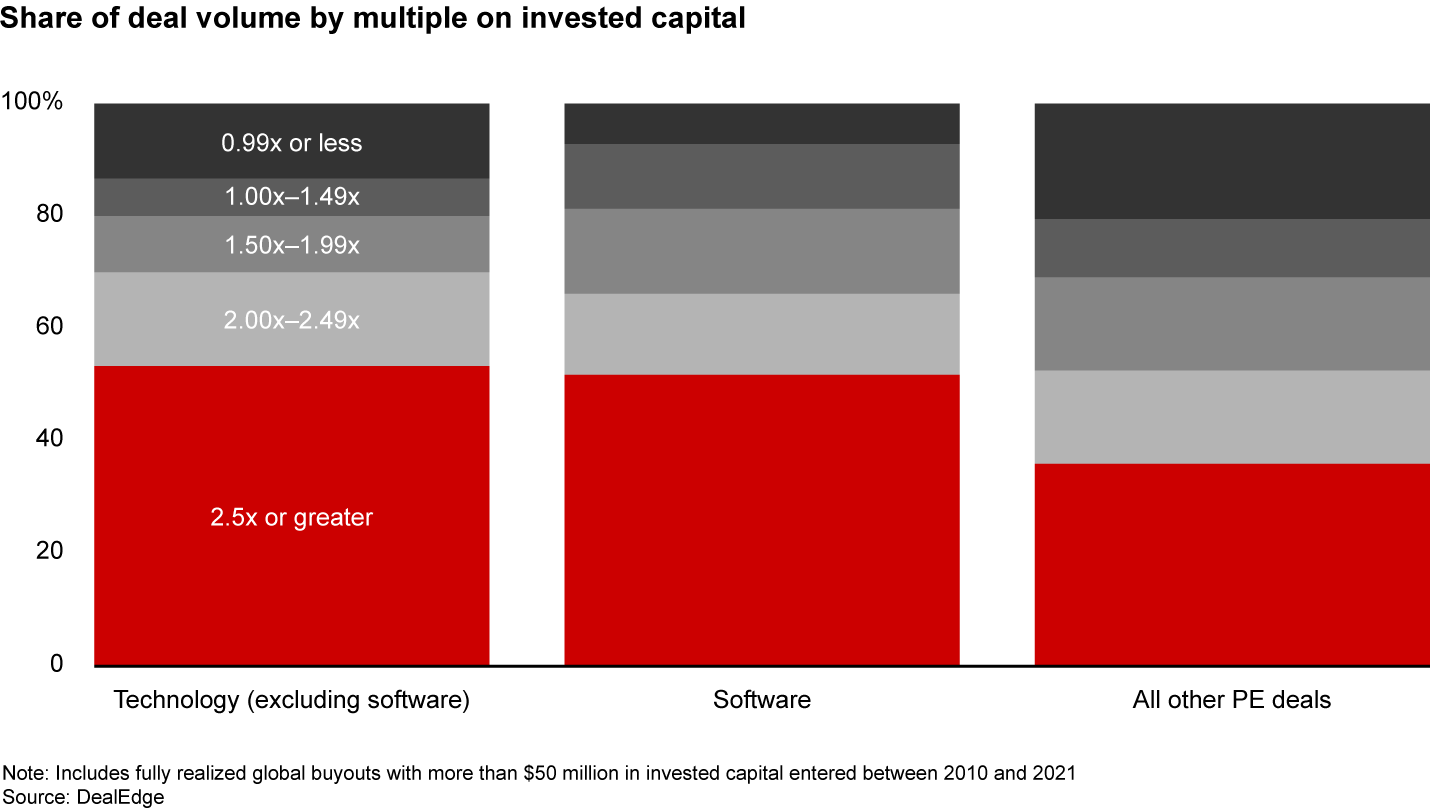
The composition of those returns is also on firmer ground. Despite the rapid expansion in technology valuations over the past decade, data from DealEdge shows that software and tech deals have both received a larger portion of their returns from earnings growth than have private equity deals generally. Multiple expansion has been the biggest factor in generating returns for PE deals more broadly (see Figure 6).
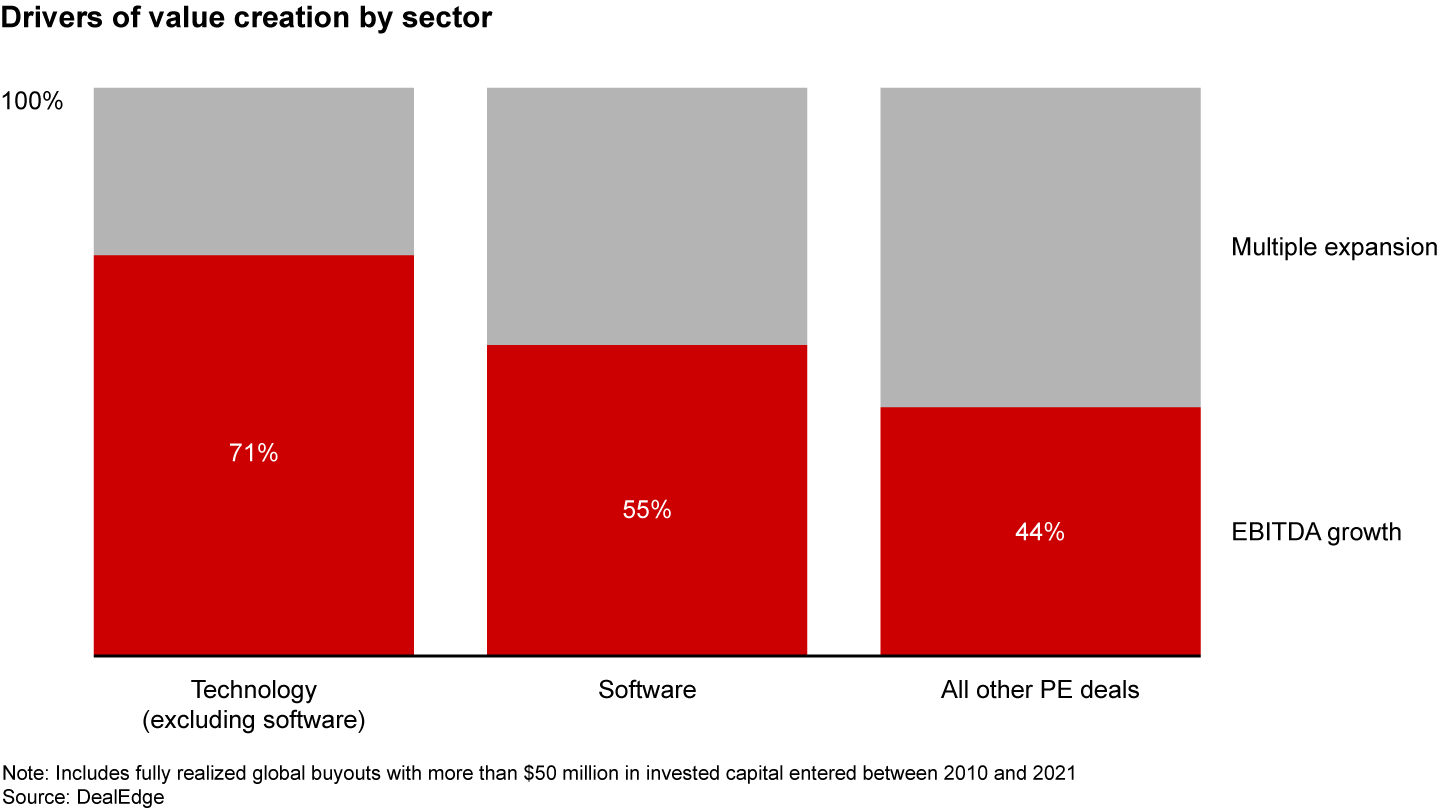
Every target is different, of course, but these superior return characteristics have a lot to do with the operating models typical of enterprise software companies. In many ways, they are tailor-made for leveraged buyouts. While they tend to have strong revenue growth, they are also capital light; there are no factories or other hard assets to suck up capital. They do require investment to acquire and maintain scale, but once there, fat gross margins mean they tend to churn out a steady stream of cash.
This is especially true of software-as-a-service (SaaS) companies, which use subscription models to smooth out revenue and cash generation. In the early days of SaaS, the worry was that subscriptions would make it easy for customers to jettison a software provider in hard times. But that hasn’t turned out to be the case. In fact, enterprise software is especially sticky. Once a company comes to rely on a cybersecurity solution or enterprise resource planning system, for instance, it's hard to replace it, even when the macro or industry outlook sours. The cash flow, therefore, is not only steady but relatively noncyclical, ensuring that there will be plenty of cash to service the kind of debt levels taken on to enhance leveraged buyout returns.
These characteristics help explain the surge of large P2P software deals in 2021. The software companies going private are often prime buyout candidates because they face the kinds of “mature company” issues that are difficult to solve under the glare of public ownership. They might have multiple business lines acquired over time that lack synergy and efficiency. A set of legacy businesses might be weighing down another set of growth businesses. Many older software companies face the challenge of shifting to SaaS models, which requires new pricing and revenue-capture capabilities. This can lead to subpar margin profiles at the business-unit level that are not well understood by the public markets.
The firms generating top-quartile returns in tech combine differentiated expertise in specific subsectors with the ability to help management teams solve these kinds of issues post-acquisition. They also recognize that the steady performance of software companies means they can value these assets differently. While software multiples are hovering at historic highs, investors should be able to accept lower hurdle rates commensurate with the lower risk. All else being equal, this maintains the heat under valuations across the sector. Much like the inverse relationship between bond prices and yields, asset prices move in the opposite direction of return expectations. So as investors adjust hurdles downward, multiples should continue to move higher, benefiting current owners.
A full and promising pipeline
A Bain analysis of investments by the largest technology-focused investors from 2017 to 2021 shows that they have made some key shifts over the past five years. An earlier emphasis on vertical application software—products like retail inventory management systems that solve specific problems for a specific kind of customer—has given way to a growing focus on companies developing infrastructure and horizontal software (see Figure 7). The fintech vertical is one glaring exception. Fintech’s share of tech portfolios has grown by 30% as investors look to stay involved in the ongoing digital transformation of banking and finance.
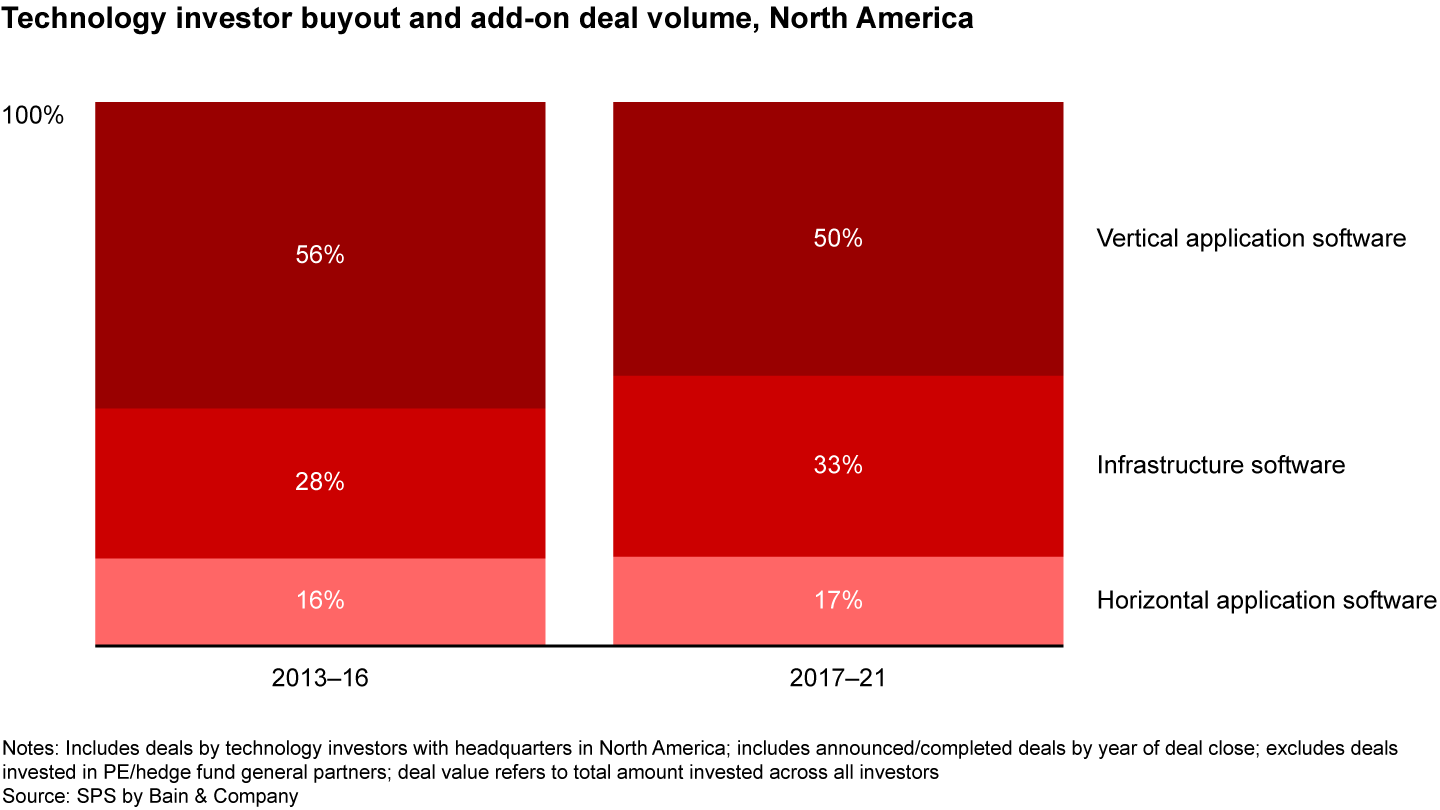
Infrastructure categories like cloud computing and cybersecurity have increased their relative share in tech portfolios by 60% and 20%, respectively, while horizontal applications such as marketing technology (martech) and customer relationship management have each jumped 13%. As these assets return to the market over the next five years, they will create the next wave of leveraged buyouts by providing attractive pockets of opportunity for future acquirers. Importantly, these subsectors are also benefiting from sustained tailwinds that show few signs of letting up.
Cloud computing. Remote delivery of software has been a thing in the technology universe since Salesforce introduced it in 1999. But over the past five years, cloud companies have captured 60% of IT market growth. While many thought growth would start to level off this year, cloud computing got a significant boost from Covid-19, as the pandemic demonstrated to companies globally the importance of flexible, disaster-resistant computing power. The majority of enterprise spending on cloud technology has so far come from tech-savvy segments of the economy, but adoption is growing among traditional industries as more and more types of companies recognize the utility and value of cloud deployment. The consensus of independent market research firms suggests that cloud spending will continue to grow in the range of 18% to 29% annually through 2024.
DevOps. Since cloud computing goes hand in hand with DevOps, cloud growth will also increase demand for companies supplying the software tools that make this burgeoning technology management model possible. DevOps merges application development with a company’s operations to speed up the delivery of products and services—and it works best in a cloud environment. According to Bain’s 2021 DevOps Pulse Survey, most companies these days are using DevOps in some capacity, and around 50% use it for the majority of their applications. As the pace of adoption accelerates, however, that percentage should grow to 90% over the next three years, driving double-digit growth for the companies whose technology enables DevOps across the development life cycle.
Martech. Technology-driven marketing tools are changing the way companies interact with their customers. They allow teams to use customer data and analytics to sharpen marketing efforts and increase customer intimacy. The subsector is growing rapidly as companies across industries race to understand their customers better and deliver more personalized experiences. According to the CMO Council, 70% of CEOs see marketing as critical to revenue growth and are willing to increase investment in technology that can raise their game. That means more opportunity for private equity, especially given that the martech ecosystem is highly fragmented. With over 7,000 vendors, there will be a steady stream of targets and opportunities for M&A strategies.
The path to value
As attractive as the software sector continues to be for investors, it is also the domain of specialists. Firms like Thoma Bravo and Vista—as well as the longstanding dedicated teams at generalist funds—have come to understand the game better than anyone else and have built strong, deep organizations calibrated to press their advantage.
The challenge software investors face isn’t just heavy competition for deals and rich asset multiples; those conditions exist across the private equity universe. What makes technology different is the complexity of the businesses, the constantly evolving nature of their industries, and the often pressing need for management teams to transition from all-out growth to sustainable profitability at scale. The firms producing top-tier results in software have developed any number of winning strategies to deal with these layers of complexity. But as a group they tend to have three things in common.
An emphasis on active ownership. The maturing software companies buyout firms tend to target are often at a critical stage of development. The founders or management team might have done a good job managing growth. But they sometimes lack the skill sets and capabilities needed to sustain that growth at scale. The most effective general partners see that as an opportunity to add significant value by helping management teams build new capabilities, processes, and operating models, while providing access to networks of specialized expertise.
Hg Capital, for example, has developed a new platform it calls the Hg Hive, a centralized repository of expertise and resources designed to accelerate learning and best-practice sharing across its portfolio. The Hive is a network of several thousand professionals and third-party subject matter experts, organized as a community that benefits the Hg portfolio. It features various centers of excellence focused on product, sales and marketing, diversity, and ESG, giving portfolio company management instant access to specialized knowledge and playbooks so they don’t have to start from scratch to build new capabilities.
The rapid emergence of cloud and SaaS business models within the software industry is providing a rich vein of opportunity for new owners to add value post-acquisition. Switching to SaaS means optimizing software development for a subscription model, while adopting DevOps to speed up product enhancements and turn software engineers into service providers, not just code writers. It also requires new go-to-market capabilities focused on selling directly to customers—skills that include increasing customer satisfaction, boosting subscription renewals, and maximizing opportunities to cross-sell and upsell. Metrics change from metering one-time license sales to managing annual recurring revenue. Fluency in using tools such as Net Promoter Score℠ to track loyalty and prevent churn becomes a core competency.
The most effective general partners add significant value by helping management teams build new capabilities, processes, and operating models, while providing access to networks of specialized expertise.
These issues all came into play for a sponsor that took private a large software company. While the target had made its mark selling on-premise systems to large enterprise clients, its next phase of growth relied on developing management tools that could draw on disparate pools of data in the cloud and make sense of them using artificial intelligence. The transition to a subscription model was central to the strategy.
Making SaaS work meant the software company had to transform its sales, marketing, and customer success organizations. To sharpen its sales effort, the company implemented a global standardized account management system, which allowed it to segment and prioritize 80 strategic accounts. It then developed account strategies for each one and defined detailed sales plays to optimize how the company approached them. The recognition that demand generation was a much bigger factor in the SaaS world triggered an overhaul of the company’s website interface and how it was using search engine optimization and paid media to increase its sales pipeline. In-market pilots using a sprint-based test-and-learn approach accelerated improvements to the marketing effort.
Maintaining an ongoing transactional relationship with subscription customers also required a different approach to working with them post-sale. Not only did that mean retraining customer service reps to meet new customer demands and drive upsell revenue, but it also became essential to integrate the customer success and sales organizations to improve consistency of support across the organization.
The results have been impressive. The customer pipeline has increased by more than 40%, and the company has seen a 15% increase in lead generation. The new emphasis on customer support has also paid off in an 85-point increase in Net Promoter Score. The sponsor recently completed a successful public offering of the rebuilt software firm at a substantial increase in value from its acquisition price.
Hyperfocus. More than in any other sector of the economy, technology investing demands differentiated expertise capable of generating proprietary insights and pattern recognition. The most effective tech specialists understand that this requires a disciplined focus on the subsectors (or sub-subsectors) they know best.
While top-quartile firms may have a range of focus areas, they recognize that winning depends on developing expertise in all of them. That requires a deep bench of internal talent and capabilities, as well as access to broad ecosystems of experts and resources that can provide added support. This pool of knowledge enhances every stage of the value-creation cycle: finding the most promising targets, underwriting value in ways most appropriate to a given subsector, and providing portfolio companies a rich well of talent post-acquisition to help navigate across an ever-changing industry landscape.
In July 2021, for instance, when Thoma Bravo took Proofpoint private in a deal valued at $12.3 billion, it was the culmination of a multiyear, multibillion-dollar bet on the sector. Thoma Bravo has been investing heavily in security since acquiring Entrust and Tripwire in 2009 and 2011, respectively. To date, it has made over 25 major investments in the sector, and the pace has accelerated in recent years to match the rapid growth and complexity of cyberthreats. Since 2019, the firm has spent at least $8 billion investing in Sophos, Veracode, ConnectWise, and Imperva, among others. Yet the push has been highly targeted. The firm has maintained a deliberate focus on what it knows best—subsectors such as endpoint security, content security, network security, and identity access management.
This disciplined focus has led to differentiated expertise. Thoma Bravo lists seven investment professionals as cybersecurity specialists, a much higher concentration in a single sector than most firms. Its deal teams have developed the kind of high-level pattern recognition that allows them to understand which trends are most meaningful in the space and which companies are best positioned to capitalize on them. Teams know which key performance indicators are critical to measuring success and how companies at various stages of growth and development should be performing against them. They recognize how to unlock pockets of value by improving salesforce effectiveness or sharpening cross-selling and pricing strategies. They can tap into high-quality networks and relationships built over years of investing.
It all adds up to an ability to find the right targets, diligence them faster and more effectively than rivals, and then work with management teams to develop and execute the right value-creation plan.
Flexibility in capital deployment. One implication of buyout investors deepening their expertise and networks in technology is that they are seeing opportunities to target companies at earlier stages of development. Their funds, however, tend to have restrictive mandates that prevent them from making minority investments in growth-stage companies. So they have increasingly been launching early-stage discovery funds like Blackstone Growth, Bain Capital Tech Opportunities, or KKR’s Next Generation Technology Growth. Minority-stake software deals have grown 25% annually since 2015, while buyout deals have grown only 5%.
Firms are also finding ways to stay invested in good deals longer, either by turning a minority deal into a control stake or maintaining an interest in a promising company post-exit. This has to be balanced with the need to return capital to limited partners, but the logic of staying with a winner is compelling. Many software companies play in winner-take-most markets, where it may be difficult to maintain exposure by finding other good investments. As noted earlier, it’s also true that as these companies mature, they develop sticky relationships with customers that drive steady, reliable cash flow, making it attractive to stay involved longer in their life cycle. Finally, as PE firms develop expertise in a sector, they also deepen their ability to add value to portfolio companies, especially as their strategies mature.
Hg Capital, for instance, recently took a majority stake in Sovos through its flagship Saturn 2 fund, four years after the firm initially took a controlling interest in the company through the Hg Capital 7 fund. Sovos develops tax software to help multinational or multijurisdiction businesses manage compliance wherever they operate. Rather than only trying to develop software that could solve for different tax rules and regulations in markets across geographies, it has become a serial acquirer of smaller software companies globally.
Hg’s global M&A expertise and focus on tech related to regulation had helped Sovos bring a more strategic approach to its international footprint expansion. And as the company moved to consolidate and integrate its new partners, Hg saw an opportunity to participate more fully in the next wave of growth.
Managing the risk
The enduring appeal of software companies over the past decade has been their power to disrupt. More than any other aspect of the digital revolution, software has demonstrably changed how we live and conduct business. All indications suggest that enterprise software will continue to fuel the economy, generating rich opportunity for private equity investors.
But as buyout firms negotiate a fiercely competitive market characterized by chronically high asset multiples, three points stand out.
- First, investors shouldn’t expect that strong software assets will see multiple declines from today’s levels. As we’ve noted, the superior economics and ongoing growth prospects for B2B software companies will continue to put upward pressure on multiples. For the foreseeable future, buyout firms will have to be prepared to stretch and pay up for the most attractive assets.
- Second, you’d better know what you’re doing. Paying full price with conviction requires deep expertise, both internally and through an ecosystem of advisers and experts. The firms that lead this market know how to do their homework. They develop truly proprietary insights, underwrite them in due diligence, and then develop a clear and robust value-creation plan that can be executed practically during ownership.
- Finally, generating returns given high purchase multiples will require digging in to help management teams prepare for the next phase of growth. That means improving capabilities, operating more efficiently, and developing the kinds of commercial excellence initiatives that are critical to growth at scale. It could also involve building a new SaaS business model, expanding globally, or moving into unfamiliar adjacencies.
Business building at this stage of the game is all about helping portfolio companies avoid the stall-out that so often accompanies scale. Software companies still have a lot more of the world to consume. For buyout firms, the strongest returns will come from helping them do so as mature, efficient competitors.
Net Promoter Score℠ is a service mark of Bain & Company, Inc., Satmetrix Systems, Inc., and Fred Reichheld.





